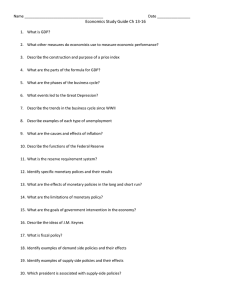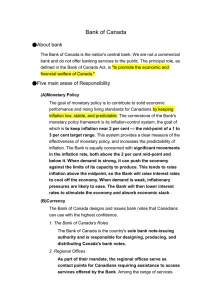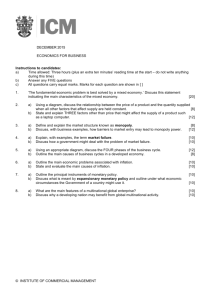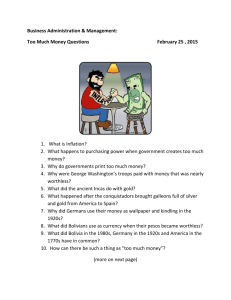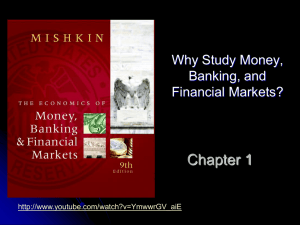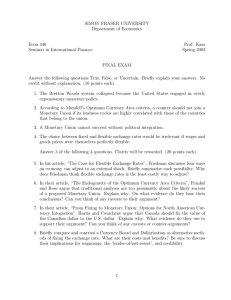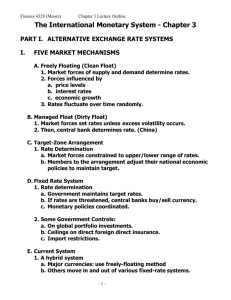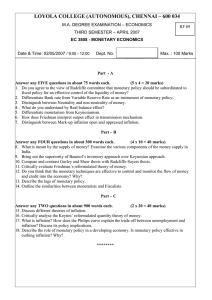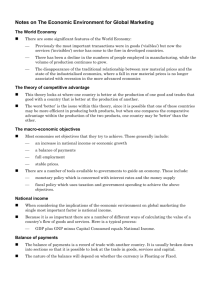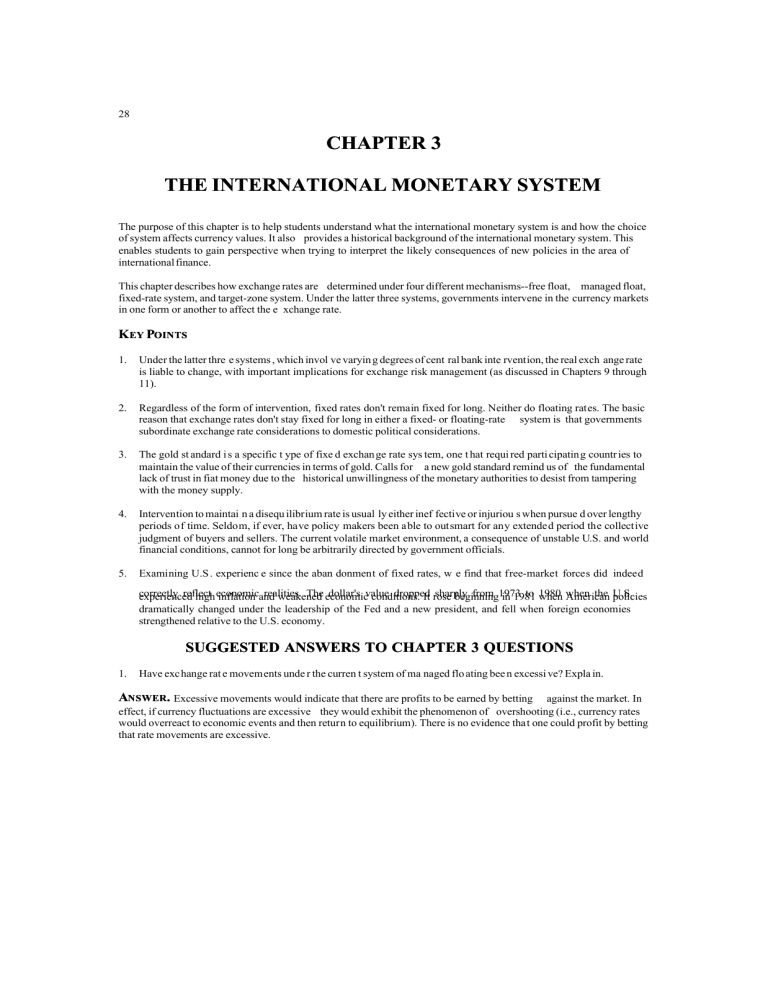
28 CHAPTER 3 THE INTERNATIONAL MONETARY SYSTEM The purpose of this chapter is to help students understand what the international monetary system is and how the choice of system affects currency values. It also provides a historical background of the international monetary system. This enables students to gain perspective when trying to interpret the likely consequences of new policies in the area of international finance. This chapter describes how exchange rates are determined under four different mechanisms--free float, managed float, fixed-rate system, and target-zone system. Under the latter three systems, governments intervene in the currency markets in one form or another to affect the e xchange rate. K EY POINTS 1. Under the latter thre e systems , which invol ve varyin g degrees of cent ral bank inte rvention, the real exch ange rate is liable to change, with important implications for exchange risk management (as discussed in Chapters 9 through 11). 2. Regardless of the form of intervention, fixed rates don't remain fixed for long. Neither do floating rates. The basic reason that exchange rates don't stay fixed for long in either a fixed- or floating-rate system is that governments subordinate exchange rate considerations to domestic political considerations. 3. The gold st andard i s a specific t ype of fixe d exchan ge rate sys tem, one t hat requi red parti cipatin g countr ies to maintain the value of their currencies in terms of gold. Calls for a new gold standard remind us of the fundamental lack of trust in fiat money due to the historical unwillingness of the monetary authorities to desist from tampering with the money supply. 4. Intervention to maintai n a disequ ilibrium rate is usual ly either inef fective or injuriou s when pursue d over lengthy periods of time. Seldom, if ever, have policy makers been able to outsmart for any extended period the collective judgment of buyers and sellers. The current volatile market environment, a consequence of unstable U.S. and world financial conditions, cannot for long be arbitrarily directed by government officials. 5. Examining U.S . experienc e since the aban donment of fixed rates, w e find that free-market forces did indeed correctly reflect realities. The economic dollar's value dropped sharply from 1973 to when 1980 when the U.S. experienced high economic inflation and weakened conditions. It rose beginning in 1981 American policies dramatically changed under the leadership of the Fed and a new president, and fell when foreign economies strengthened relative to the U.S. economy. SUGGESTED ANSWERS TO CHAPTER 3 QUESTIONS 1. Have exc hange rat e movem ents unde r the curren t system of ma naged flo ating bee n excessi ve? Expla in. ANSWER. Excessive movements would indicate that there are profits to be earned by betting against the market. In effect, if currency fluctuations are excessive they would exhibit the phenomenon of overshooting (i.e., currency rates would overreact to economic events and then return to equilibrium). There is no evidence that one could profit by betting that rate movements are excessive. CHAPTER3:THEINTERNATIONALMONETARYSYSTEM 2. 29 Why has speculation failed to smooth exc hange rate m ovements? ANSWER. Speculation can only be expected to smooth exchange rate movements if underlying economic processes are relatively stable. If there is a great deal of uncertainty over future government actions and their economic impact, expectations will not be strongly held. Thus expectations can change dramatically from day- to-day, leading to rapidly fluctuating exchange rates. 3. Is a floating-rate system more in flationary than a fixe d-rate system? Explain. ANSWER. To the extent that floating exchange rates allow monetary authorities to pursue more inflationary policies, then a floating rate system can be more inflationary. However, this is an indirect effect, the direct cause of inflation being rapid money expansion. According to PPP, the direction of causation runs from price level changes to exchange rate changes, not vice versa. 4. Find a rec ent exam ple of a natio n's fore ign exch ange mar ket inte rvention and note w hat the gov ernment's justification was. Does this justification make economic sense? ANSWER. Finding an example of foreign exchange market intervention by a government should be pretty easy to do. The trick will be to find a coherent statement of what the make little or no economic sense. 5. government's justification was. Most of these justifications Gold has been called " the ulti mate burglar alarm." Explain what this e xpression means. ANSWER. Governments "burgle" holders of their currencies by printing more money and subjecting holders to an "inflation tax." Since gold prices respond quickly to evidence of inflation, the expectation of an increase in inflation will cause a jump in gold prices. In this way, gold serves as a burglar alarm to warn that politicians are tampering with fiat money. 6. Since 1979, the price of gold has fallen by more than 60%. What could explain such a steep price decline? Consider the roles of inflation and new financial instruments such as swaps and options that can provide lower-cost inflation hedges. ANSWER. Gold traditionally has provided a safe haven when economic and political conditions are uncertain and currencies are volatile because of the belief that it was a sounder store of value than paper money. However, gold's value as an inflation hedge was diminished during the 1980s as inflation became a much less serious concern. At the same time, to the extent that modern financial instruments such as swaps and options now provide better, less costly shelters (especially since gold pays no interest, imposing a high opportunity cost on holders), these lower cost inflation-hedge substitutes would have the effect of reducing the demand for gold and hence its price relative to what it would be absent these lower-cost inflation-hedge substitutes. The jump in the price of gold during 1993 may be due to the growing wealth of many Chinese and their attempt to avoid the high inflation stemming from the Bank of China's expansionary monetary policy . Given their lack of access to more sophisti cated hedging instruments, the Chinese may have found gold to be their best inflation hedge. Currency concerns have also played a role in gold's rally during 1993. Until recently, the Bundesbank has been the only reliable policeman putting the fight against inflation as its first priority. Now that's questionable as the Bundesbank has to deal with the pressures brought on by the German recession to put economic expansion ahead of price stability as its priority. These concerns about the DM as a store of value have been reflected in a fall in its exchange rate. 7. Comment on the followi ng statem ent: "A syst em of floati ng exchang e rate fails whe n governm ents ignor e the verdict of the exchange markets on their policies and resort to direct controls over trade and capital flows." 30 INSTRUCTORS MANUAL: FOUN DATI ONS OF M ULTI NATI ONAL F INAN CIAL M ANAG EMEN T, 4TH ED. ANSWER. Floating offers, in principle, a small degree of freedom from the subordination and coordination necessary to maintain stable exchange rates. But if governments abuse that degree, and refuse to accept the exchange rate consequences (e.g., a drop in the exchange rate due to rapid expansion of the money supply), the system will fail. That is, if the governments involved wish to pursue independent policies while simultaneously stabilizing e xchange rates, this can be accomplished only by imposing direct controls on trade and capital flows. 8. Suppose nations a ttempt to pu rsue inde pendent monetar y and fiscal po licies. How wil l exchang e rates beha ve? ANSWER. Independent monetary and fiscal policies will lead to volatile exchange rates as market participants receive and assess new information on these policies. 9. Will coordination of e conomic polic ies make excha nge rates more o r less sta ble? Exp lain. ANSWER. Coordination of economic policies will make exchange rates more stable, since the relative attractiveness of the various currencies is less likely to change significantly. 10. The experiences of fixed exchange-rate sy stems and target-z one arrangemen ts have not been entirely satisfact ory. a. What lessons can economists draw from the breakdown of the Bret ton Woods system? ANSWER. Adjusting monetary growth rates is the principal way to stabilize exchange rates. For example, raising the value of the dollar relative to the yen requires tightening U.S. monetary policy relative to Japanese monetary policy. The experience of Bretton Woods and similar experiments demonstrates that conscious and explicit coordination of monetary policies among sovereign authorities is difficult. The problem stems from the inability of sovereign authorities to coordinate their monetary growth rates. An agreement to stabilize the dollar at, say, 150 yen would be relatively easy if it did not entail interdependent monetary policies, robbing the Federal Reserve, or the Bank of Japan, or both, of important degrees of monetary freedom. Both Japan and the United States have their own targets for growth and inflation and their own independent assessment of the macroeconomic policies required to attain those targets. Except by coincidence, independent policies and preferences will not mesh at a stable exchange rate. Given clashing preferences, the only alternatives to the "chaos" of floating are: (1) One side persuades the other t o change its pol icies; (2) One side s ubordina tes its pol icies to th ose of the ot her; or (3) Both sid es subord inate the ir monet ary polic ies to an extern al mechanism , such as a gold standard. Absent (3), "international monetary reform" is the search for new ways to implement (1) or (2), or some combination. We sa w that Bretton Woods collapsed because the subordination it entailed was intolerable to the United State. That is, the United States refused to follow economic policies that would maintain the value of gold at $35 an ounce. The basic lesson from Bretton Woods, therefore, is that stabilizing exchange rates requires dependence and subordination, not the freedom for everybody to do their own thing. But instead of changing policies to stay with the Bretton Wood s system, the major countries simply dropped the system. b. What lessons can economists draw from the exchange rate experiences of the European Monetary System? CHAPTER3:THEINTERNATIONALMONETARYSYSTEM 31 ANSWER. Exchange rate stability requires that monetary policies be coordinated and geared towards maintaining exchange rate parities. The slow progress of the European communi ty with respect to the EMS and policy coordination exemplifies the difficulties of achieving agreements on the many facets of economic policymaking. Implementing target zones on a wider scale would be all the more difficult. Differences in preferences, policy objectives, and economic structures account in part for these difficulties. More fundamentally, however, coordination of macroeconomic policies will not necessarily benefit all participant countries equally, and those that benefit the most may not be willing to compensate those that benefit least. In the EMS, Germany is less inflation-prone than the other members and is reluctant to cooperate at the risk of increasing its inflation rate. Another lesson is that in target-zone arrangements such as the EMS, a disproportionately large share of the adjustment burden will fall on the "weak" currency countries. Countries with appreciating currencies, trade surpluses, and increasing reserves are less prone to adjust than countries with depreciating currencies, trade deficits, or reserve losses. The convergence of inflation rates among the EMS countries supports this view. An equal sharing of the adjustment burden implies that inflation rates among member nations would converge to the average rate. Germany, however, has maintained a domestic monetary target of low or zero inflation, and often has refused to alter domestic monetary policy because of exchange rate considerations. Because of Germany's economic importance, the other member countries have had to adjust their domestic policies or their exchange rates to remain competitive in international markets. As a result, inflation rates have tended to converge toward Germany's lower rate. 11. Despite offici al parity betwee n the Deutsche m ark and the Ostmark, the black mark et rate in early 1990 was about ten Ostmarks for one Deutsche mark. What problems might setting the exchange rate at one Ostmark for each DM create for Germany? ANSWER. The basic problem is that at a one-for-one exchange rate the Ostmark will be overvalued relative to the Deutsche mark. Unless East German wages fall, East German industry will find their cost of doing business rising, without an offsetting gain in productivity. East German industry will become even less competitive than it already is and there will be massive unemployment in East Germany. At the same time, East Germans will rush to convert their Ostmarks to DMs. The resulting growth in the DM money supply will be inflationary unless the demand for DM grows in proportion to the supply. Clearly, the demand for DM will rise as it supplants the Ostmark as the official East German currency. Of course, the Bundesbank can always eliminate the threat of inflation by sterilizing the increase in DM through open market activities, that is, by issuing bonds to sop up the surplus Deutsche marks. In the event, Germany did set a one-for-one exchange rate, more than 30% of eastern Germans were unemployed by mid-1991 (this problem was compounded by the extremely generous German unemployment compensation system), inflation fears rose in Germany, and fewer than 10% of eas tern German companies were solvent. 12. How did the European Monetary S ystem limit the economic ability of each member nation to set its interest rate to be different from Germany's? ANSWER. Each country within the European Monetary System had to fix its exchange rate relative to the DM. If a country's exchange rate is expected to stay fixed relative to the DM, the interest rate associated with that country's currency cannot diverge from Germany's. Otherwise, it would present a virtually risk-free arbitrage opportunity: Borrow in the lower interest rate currency and lend the borrowed funds in the higher interest rate currency and earn the spread betwe en the two rate s. 13. Historically, Spain has had high inflation and has seen its peseta conti nuously depreciate. In 1989, though, Spain joined the EMS and pegged the peseta to the DM. According to a Spanish banker, EMS membersh ip means that "the government has less capability to manage the currency but, on the other hand, the people are more trusting of the currency for that reason." a. What underlies the peseta's historical weakness? ANSWER. Spain has historically pursued an easy monetary policy, with an associated high rate of inflation. High inflation, in turn, led to continual peseta devaluation. 32 INSTRUCTORS MANUAL: b. FOUN DATI ONS OF M ULTI NATI ONAL F INAN CIAL M ANAG EMEN T, 4TH ED. Comment on the banker's statement. ANSWER. Countries that seek to participate in the EMS are effectively forced to pursue a monetary policy consistent with that of Germany, which eventually brings down their inflation rates. In effect, control of Spain's monetary policy has been shifted from Spain's central bank, which has a weak reputation for monetary discipline, to the much more reputable Bundesbank. Thus, Spaniards now are more trusting of their money. c. What are the likely c onsequen ces of EMS membership o n the Span ish publ ic's wil lingness to save an d invest ? ANSWER. By heightening the prospects for Spanish monetary stability, EMS membership has lowered the risks associated with holding financial assets in Spain. The result has been to make the Spanish public more willing to save and invest. 14. When Britain announced its entry into the exchange-r ate mechanism o f the EMS on October 5, 1990 , the price of British gilts (long-term government bonds) soared and sterling rose in value. a. What might account for these price jumps? ANSWER. By entering the exchange-rate mechanism, Britain has effectively foresworn devaluation of the pound against the DM. In order to maintain the pound's value, Britain must now follow a more disciplined and anti-inflation monetary policy. Expectations of lower inflation and fewer currency swings in the future raised the demand for British assets, including pounds, thereby reducing interest rates (the interest rate is the inverse of the bond price) and raising the pound's value. Put another way, as we will see in Chapter 8, expectations of lower inflation reduce interest rates (the Fisher effect) and boost the value of a nation's currency (purchasing power parity). b. Sterling entered the ERM at a central rate against the DM of DM 2.95, and it is allowed to move within a band of plus and minus 6% of this rate. What are st erling's uppe r and lower rates against the DM? ANSWER. Sterling's lower limit against the DM is .94 x 2.95 = DM 2.77; its upper limit is 1.06 x 2.95 = DM 3.13. 15. What potential cos ts might be associated w ith the decision to wide n the margins withi n which some curren cies in the ERM can float? ANSWER. Widening the margins reduces the credibility of the system since such a system grants greater discretion to the monetary authorities. Currency holders don't want the monetary authorities of suspect currency nations to have greater discretion. Indeed, the monetary authorities' loss of discretion associated with the ERM is viewed by most as the ERM's greatest value. For suspect currencies, the loss of credibility will likely lead to higher interest rates and more speculative attacks. 16. In discussing European Monetary Union, a recent government report stressed a need to make the central bank accountable to the "democratic process." What are the likely consequences for price stability and exchange rate stability in the EMS i f the "Eur ofed" becomes accountable to the "democratic process?" ANSWER. The only good central bank is one that can say no to politicians. Unfortunately, the proposal makes it more difficult for the central bank to do so. Instead of assessing central bank performance in terms of an unambiguous, verifiable goal, such as price stability, thereby complementing central bank independence by giving it a single, long-term focus, the proposal's definition of accountability will provide an avenue for political influence. The result will be higher inflation, and more currency volatility. 17. Comment on t he following headline in The Wall Street Journal (January 11, 1993): "Germany's Rate Cut Takes Pressure Off French Franc, and the Rest of the EMS." CHAPTER3:THEINTERNATIONALMONETARYSYSTEM 33 ANSWER. The srcin of the September 1992 currency crisis was the Bundesbank's decision to maintain high interest rates to restrain the inflationary effects of reunification. To maintain their currencies against the D-mark, the other members of the EMS were forced to push up their own interest rates, thereby stifling economic growth in their countries. Speculators bet that Britain, Spain, and some other countries would find that trade-off unpalatable and would devalue their currencies. As long as German rates remained high, this Hobson's choice would continue to face other European governments and would maintain speculati ve pressure on their currencies. By cutting its discount rate, the Bundesbank allowed France and the other EMS members to cut their interest rates and stimulate their economies without devaluing their currencies. This interest rate cut, therefore, by reducing the likelihood that they would devalue their currencies, reduced speculative pressure. 18. The French franc w as the main target of speculators during the August 1993 assault on the EMS despite the fact that France was running a 2% inflation rate while Germany had a 4.3% inflation rate. Why might this be? ANSWER. Two words explain this situation: "credibility" and "expectations." Given the market's trust in the Bundesbank, the high G erman inflation rate was viewed as an aberration that the Bundesbank would s oon g et und er control. Conversely, currency traders were less certain of the Bank of France's long-term commitment to low inflation, especially since the Bank of France has historically been subservient to the interests of the French government. More specifically, unlike the Bundesbank , the Bank of France did not have 35 years of independence behind it and could not count on the unwavering support of a citizenry that abhors inflation. Based on the high rate of unemployment and sluggish growth in France and the growing demands by the French public for easing up on monetary policy, it was rational to assign a high probability that the Bank of France would abandon its strong franc policy. The result would be higher French inflation in the future. Conversely, the history of the Bundesbank would suggest lower German inflation in the future. Given expectations of higher French inflation and lower German inflation in the future, the foreign exchange market rationally expected a weaker French franc. Acting immediately on such expectations, speculators sold francs and bought DM. 19. In early 1996, in response to growing doubts about the ability of EC nations to meet the Maestricht criteria and move toward monetary union by the 1999 deadline, yields on European bonds jumped. What is the likely link between the doubts on Maestricht and the EC bond yield increases. ANSWER. The expectation in the financial markets is that countries that meet the Maestricht criteria will be locked into a system that is essen tially run on the same model as the Bundesbank, namely one that is committed to price stability as its one and only goal. In other words, the view is that Germany will run EMU and the dominant characteristic of the single currency is that it will be a low-inflation currency. To the extent that EMU is expected to materialize, therefore, interest rates on bonds denominated in different currencies will converge toward the rate on DM bonds, which is lower than that on other European currency bonds. Conversely, an expected movement away from monetary union lowers the probability that the other European countries will stick with the low-inflation German monetary policy. Anything that lowers probability of EMU, therefore, lowers theand odds that interest other currencies will follow a low-inflation monetary policy, the leading to expectations of higher inflation higher rates. 20. "For a fixed exchange rate system to work, the government must be able to make tight budget and monetary policies stick from the outset." Comment. ANSWER. A government that runs budget deficits and a lax monetary policy is unlikely to be able to maintain its commitment to .a fixed exchange rate. Hence, one that starts out on the wrong foot will appear to observers to be willing to make exchange rate policy subservient to other national interests. Recognizing this apparent lack of government commitment to a fixed exchange rate, speculators are more likely to attack its currency, making its ability to maintain the fixed exchange rate even more doubtful. 21. In 1996, Chancellor Kenneth Clarke called for a national debate on whether Britain should join the Europea n Monetary Union. Discuss the pros and cons for Britain of joining EMU. 34 INSTRUCTORS MANUAL: FOUN DATI ONS OF M ULTI NATI ONAL F INAN CIAL M ANAG EMEN T, 4TH ED. ANSWER. By joining EMU, Britain would lock itself into a new European monetary policy. Provided this monetary policy is dominated by Germany, it is likely to be a low-inflation policy. At the same time, the single-currency aspect of EMU will reduce currency risk and foreign exchange trading costs for British firms. These features are all pluses. However, Britain would also lose the ability to conduct an independent monetary policy. To the extent that economic shocks affect Britain differently than it affects other members of EMU, losing the flexibility to adjust monetary policy or its exchange rate to cope with thes e shocks could be quite costly in terms of lost economic output. In other words, Britain combined with continental Europe may not constitute an optimum currency area. The costs of fixing exchange rates was demonstrated when Britain and other European nations were forced to raise their interest rates to maintain their exchange rates fixed to the DM even as Germany was coping with the shock of reunification. 22. Upon taking off ice in October 1993, the Bun desbank's new president, Hans Tietmeyer, said, "Forced reductions in central bank interest rates which are contrary to stability policies can neither solve economic or structural problems. But they would undermine trust in currency values, drive long-term interest rates higher and delay necessary corrections in the real economy." Explain the context in which Mr. Tietmeyer made these comments. Do you agree or disagree with his comments. Explain. ANSWER. Mr. Tietmeyer was responding to a chorus of complaints following the currency crisis of August 1993 which, in turn, led to the abandonment of the Exchange Rate Mechanism. The August crisis was triggered by the (correct) belief that the Bundesbank would not reduce its interest rates sufficiently to permit cuts in interest rates in other ERM countries such as France and Denmark where unemployment was high and inflation low. What Tietem ayer said, in effect, was "Don't blame Germany for your high unemployment and slow growth. Monetary policy is not a good tool to use in stimulating an economy. You will just wind up with high inflation and higher real interest rates. Rather, you should focus on correcting the structural problems that are drivin g your high unemployment rates, such as high taxes, a less productive workforce, a subservient central bank (leading to a risk premium), and expensive labor regulations." 23. Comment on the following stateme nt: "Wage flexibility is a substitute, albeit an imperfect one, for exchange rate flexibility." ANSWER. If an economic shock leads to domestic imbalances between supply and demand, a change in the exchange rate can bring about the necessary changes in prices and wages to reestablish competitiveness. However, if the exchange rate is fixed, then wages and prices themselves must change to respond to domestic imbalances. Wage flexibility will go a long way to achieving this end, but it is imperfect since flexibility in the prices of goods and services is also an important element in adapting to changed economic circumstances. 24. Comment on the fol lowing statement: "W ith monetary uni on, the era of protectio n for European firm s and workers has come to an end." ANSWER. As explained in the answer to the previous question, wage flexibility is a substitute, albeit an imperfect one, for exchange rate flexibility. If exchange rates can no longer adjust in response to domestic imbalances, then wages need to become more flexible to avoid an increase in the already high rate of European unemployment. But labor market institutions in Europe tend to impede such flexibility. Their very purpose is to protect those currently working from the pressure of the unemployed. Nobody loses his or her job, or is obliged to accept a wage cut, even though there is a large pool of unemployed who would be willing to work at a lower wage. Job protection schemes, minimum wages, and generous unemployment benefits make it possible for unions to negotiate wage increases that are largely independent of the state of the labor market. Market flexibility is also critical for adapting to economic shocks without the aid of exchange rate changes. If a country has high unemployment because of low demand for its products, it is essential in a monetary union for firms to be able to shift resources rapidly toward products with greater demand. But throughout Europe, state subsidies, costly regulations, insufficient competition, government monopolies, and barriers to entry slow the pace of adjustment. Monetary union will force governments and society to confront the prospect that maintaining the current generous social welfare state will force a substantial increase in their already high level of unemployment, but--because of the strict Maestricht fiscal criteria–without the possibility of more state aid to mitigate the suffering. 25. Comment on the following statement: "The French view European Monetary Union as a way to break the Bundesbank's dominance in setting monetary policy in Europe." CHAPTER3:THEINTERNATIONALMONETARYSYSTEM 35 ANSWER. In order to peg the franc to the DM, the French must match the Bundesbank's anti-inflationary policy. This necessity precludes France from following the expansionary monetary policy it has historically preferred. The only way for France to maintain a fixed exchange rate while following a more expansionary monetary policy is to do away with the Bundesbank. European Monetary Union will take control over monetary policy away from the Bundesbank and place it in the hands of the European Central Bank. If France can control the ECB, as it is trying to do, the result will be a more expansionary monetary policy with higher inflation. This scenario explains why Germans are so nervous over EMU; they distrust the French commitment to price stability. German suspicions were intensified in late 1997 when the French government nominated Jean- Claude Trichet, governor of the Bank of France, to be the first president of the ECB. The basic problem is the historical French government attachment to deficit spending, inflation, and devaluation as remedies for French unemployment. Such policies don't work, however, for obvious reasons. Government job creation substitutes make-believe jobs for real ones, at the same time lowering the efficiency of the real economy through heavier tax burdens. Inflationary monetary policy meanwhile retards capital formation and leads to slower growth. The real solution to high unemployment is economic growth, which requires curbing the welfare state with its high taxes, incentive-destroying benefits and subsidies, and costly labor market regulations. SUGGESTED SOLUTIONS TO CHAPTER 3 PROBLEMS 1. On Friday, September 13, 1992, the li ra was worth DM 0.0013065. Over the weekend, the lira devalued against the DM to DM 0.0012613. a. By how much has the lira devalued against the DM? ANSWER. Using Equation 2.1, the lira devalued by (0.0012613 - 0.0013065)/0.0013065, or -3.46%. b. By how much has the DM appreciated against the lira? ANSWER. Using Equation 2.2, the DM appreciated against the lira by [(1/0.0012613) - (1/0.0013065)]/(1/0.0013065), or 3.58%. c. Suppose Italy borrowed DM 4 bil lion, wh ich it sold to pr op up the lira. W hat were the Bank of It aly's lir a losses on this currency intervention? ANSWER. Prior to devaluation, DM billion was worth Lit (4 billion/0.0013065). Following devaluation, the DM 4 billion borrowing would cost Lit (4 billion/0.0012613) to repay. Hence, the Italian government would lose Lit 4 billion x [(1/0.0012613) - (1/0.0013065)] = Lit 109,716,164344, or DM 138,384,998 at the new exchange rate. d. Suppose Germany spent DM 24 billion in a n attempt to defe nd the lir a. What w ere the B undesbank's DM losses on this currency intervention? ANSWER. The Bundesbank would have bought Lit 24 billion/0.0013065. Following lira devaluation, these lira would be worth DM (24 billion/0.0013065) x 0.0012613, or DM 23,169,690,012. The result is a foreign exchange loss for the Bundesbank of DM 830,309,988 on this currency intervention. 2. The central rates for the Spanish and Belgian currencies on March 20, 1997, were Ptas 163.826/ECU and BF 39.7191/ECU. What central cross rate between these two currencies did these central rates imply? ANSWER. These rates imply a central cross rate between the two currencies of Ptas 4.1246/BF (163.826/39.7191), or equivalently, BF 0.242447/Ptas (39.7191/163.826). 36 INSTRUCTORS MANUAL: FOUN DATI ONS OF M ULTI NATI ONAL F INAN CIAL M ANAG EMEN T, 4TH ED. 3. Suppose the central rat es within the ERM f or the Fre nch fran c and DM are F F 6.90403:ECU 1 and DM 2.05853:ECU 1, respectively. a. What is the cross-exchange rate between the franc and the mark? ANSWER. Since things equal to the same thing are equal to each other, we have FF 6.90403 = DM 2.05853. Hence, FF1 = DM 2.05853/6.90403 = DM 0.298164. Equivalently, DM 1 = FF 6.90403/2.05853 = FF 3.35386. b. Under the former 2.25% margin on either side of the central rate, what were the approximate upper and lower intervention limits for France and Germany? ANSWER. Given the answer to part a, the French franc could rise to approximately DM 0.298164 x 1.0225 = DM 0.304872 or fall as far as DM 0.298164 x 0.9775 = DM 0.291455. Similarly, the upper limit for the DM is FF 3.42933 and the lower limit is FF 3.27840. c. Under the new 15% margin on eit her side o f the cent ral rate , what ar e the curr ent appr oximate upper a nd lower intervention limits for France and Germany? ANSWER. Given the answer to part a, the French franc could rise to approximately DM 0.298164 x 1.15 = DM 0.342888 or fall as far as DM 2.98164 x 0.85 = DM 0.253439. Similarly, the upper limit for the DM is FF 3.85694 and the lower limit is FF 2.85078. 4. A Dutch company exporti ng to France has FF 3 million due in 90 days. Suppose that the current exchange rate is FF 1 = DFl 0.3291. a. Under the exchange rate mechanism, and assuming central rates of FF 6.45863/ECU and Dfl 2.16979/ECU, what is the central cross-exchange rate between the two currencies? ANSWER. Given central rates of DFl 2.16979:ECU and FF 6.45863:ECU for the Dutch guilder and French franc, respectively, the central cross rate between the two currencies is DFl 1 = FF 2.97662 (6.45863/2. 16979). Equivalen tly, FF 1 = DFl 0.335952 (2.16979/6.45863). b. Based on the answer to part a, what is the most the Dutch company could lose on its French franc receivable, assuming that France and the Netherlands stick to the ERM with a 15% band on either side of their central cros s rate? ANSWER. At worst, the French franc can fall by 15% relative to its central guilder cross rate, to a cross-exchang e rate of FF 1 = DFl 0.285559 (0.335952 x 0.85). Since the curren t exchange rate is FF 1 = DFl 0.3291, the most the Dutch company can lose on its FF 3 million receivable is 3,000,000 x (0.3291 - 0.285559) = DFl 130,622. c. Redo part a, ass uming the band w ere na rrowed to 2.25 %. ANSWER. If the band were narrowed to 2.25%, then the minimum value for the French franc would be DFl 0.328393 and the maximum loss that the Dutch company could sustain would be d. 3,000,000 x (0.3291 - 0.328393) = DFl 2,121. Redo part b, assuming you know nothing about the current cross-exchange rate. ANSWER. Knowing nothing about the current cross-exchange rate, the worst that could happen is that the cross rate would be at its upper bound of DFl 0.386345 (0.335952 x 1.15) and it falls to its lower bound of 0.285559 (estab lished in the answer to part b). In this case, the maximum possible loss is 3,000,000 x (0.386345 - 0. 285559) = DFl 302,357. CHAPTER3:THEINTERNATIONALMONETARYSYSTEM 37 5. As mentioned in the chapter, during the currency crisis of September 1992, the Bank of England borrowed DM 33 billion from the Bundesbank when a pound was worth DM 2.78 or $1.912. It sold these DM in the foreign exchange market for pounds in a futile attempt to prevent a devaluation of the pound. It repaid these DM at the post-crisis rate of DM 2.50:£1. By then, the do llar:pound exchange rate was $1.782:£1. a. How much had the pound st erling dev alued in the inte rim agai nst the Deut sche mark ? Against the dollar? ANSWER. During this period, the pound depreciated by 10.1% against the pound 2.50 − 2.78 = - 10.1% 2.78 and by 6.8% against the dollar 1.782 − 1.912 = - 6.8% 1.912 b. What was the cost of i ntervention to the Bank of England in pounds? In dollars? ANSWER. The Bank of England borrowed DM 33 billion and must repay DM 33 billion. When it borrowed these DM, the DM was worth £0.3597, valuing the loan at £11.87 billion (DM 33 billion x 0.3597). After devaluation, the DM was worth £0.4000. Hence, the Bank of England's cost of repaying the DM loan was £13.20 billion (DM 33 billion x 0.4), a rise of £1.33 billion. Thus, the cost to the Bank of England of this DM borrowing and intervention was £1.33 billion. In dollar terms, intervention cost the Bank of England $825 million. This estimate is based on the difference of $0.025 between the DM's initial value of $0.6878 (1.912/2.78) and its ending value of $0.7128 (1/2.50) times the DM 33 billion borrowed and spent defending the pound. Specifically, the cost calculation is $0.025 x 33,000,000,000 = $825 million. 6. Panama adopted the U.S. dollar as its official paper money in 1904. There is currently about $400 million to $500 million in U.S. dollars circulating in Panama. If interest rates on U.S. Treasury securities are 7%, what is the value of the seigniorage that Panama is forgoing by using the U.S. dollar instead of its own-issue money? NSWER. Instead of using U.S. dollars as its currency in circulation, the Panamanian governme nt could substitute its A own currency and invest the $400 million to $500 million in U.S. Treasury securities. This policy would earn the Panamanian government $28 million to $35 million annually at the current 7% interest rate. Thus, the Panamanian government is foregoing seignorage worth $28 million to $35 million annually. The present value of this seig norage equals the amount of U.S. dollars in circulation, or $400 million ($28 million/.07) to $500 million ($35 million/.07). 7. By some estimates, $185 billion to $260 billion in currency is held outside the United S tates. a. What is the value to the United States of the seigniorag e associated with these ove rseas dollars ? Assume that dollar interest rates are about 6%. ANSWER. The annual value of seignorage equals the foregone interest on the currency held outside the United States. Based on the numbers presented in the question, this annual value varies between $11.1 billion (0.06 x $185 billion) and $15.6 billion (0.06 x $260 billion). If this money stays overseas permanent ly, then the value of seignorage is jus t equal to the amount of dollars held outside the United States, or $185 billion to $260 billion. In other words, the United States receives goods and services worth this amount of money from foreigners and paid for them with pieces of green paper that are never redeemed for U.S. goods and services. 38 INSTRUCTORS MANUAL: b. FOUN DATI ONS OF M ULTI NATI ONAL F INAN CIAL M ANAG EMEN T, 4TH ED. Who in the United States realizes this seigniorage? ANSWER. The U.S. government realizes this seignorage. Who in the United States benefits from this seignorage is an issue in political economy and depends what the government does with the money: cuts taxes, spends it (which raises the further question of on whom), uses it to reduce the deficit, etc.
